|
|
|
Sort Order |
|
|
|
Items / Page
|
|
|
|
|
|
|
| Srl | Item |
| 1 |
ID:
193223
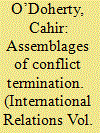

|
|
|
|
|
| Summary/Abstract |
The question of how wars end is of continued importance, especially in the context of the ongoing War on Terror. This question has traditionally been approached within International Relations through rational choice theories, logical modelling and game theory. Such approaches have become increasingly ill-suited to capturing the complexity and ambiguity of contemporary warfare and the War on Terror in particular. These battlefield ambiguities are often at odds with political and public desires to see decisive victory in wars. This article builds on recent critical work within War Termination Studies in order to re-conceptualise the end of war as assemblages. By paying greater attention to the affects inculcated by political rhetoric surrounding war and utilising the concepts of affect and emergence, this article presents a novel approach to the study of contemporary war termination. Utilising popular culture, increasingly seen as a crucial site of global politics, the case study analysed here advances the argument that sacrifice emerges from cinema and presidential rhetoric as a trope that allows leaders to claim victory in war despite indecisive conditions of the ground. Through affective cinematic encounters, conceptualised here through the end of wars assemblages, audiences can become more accepting of such political claims.
|
|
|
|
|
|
|
|
|
|
|
|
|
|
|
|
| 2 |
ID:
185758
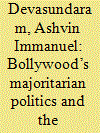

|
|
|
|
|
| Summary/Abstract |
India’s mainstream film industry has increasingly fallen under the influence of the Hindu nationalist ruling party and its agenda. But a thriving, multilingual independent sector is producing creative counternarratives.
|
|
|
|
|
|
|
|
|
|
|
|
|
|
|
|
| 3 |
ID:
087510
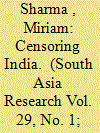

|
|
|
|
|
| Publication |
2009.
|
| Summary/Abstract |
During the early twentieth century, the emerging medium of cinema in British India became a distinctly contested political issue, revealing the tensions and limitations of empire. The record on cinematographic censorship indicates a number of competing interests and changing views, while political transformations and messy realities on the ground defied the efficacy of censorship. Even as many Indian filmmakers sought to convey messages of nationalist aspirations, the perceived need to guard against the revolutionary thoughts of communism and ideas from America that seemed to promote democracy and promiscuity fuelled censorship as a major multivocal imperial policy. Beset by many obstacles, it sought to control the exhibition of both Indian and foreign cinematic productions.
The article seeks to understand the genealogy of censorship derived from prior British attempts to regulate literary and dramatic productions. In the 1920s, anxieties about the maintenance of law and order and protection of British rule during a period of increasing Indian nationalist unrest had to be integrated with various concerns about deteriorating economic conditions. As Indian cinema struggled to come into its own, the issue of control became a central concern for both coloniser and colonised, while both faced threats from the influx of foreign (especially Hollywood) films.
The article also explores why it was deemed so important to bring cinema under the colonial gaze. While there was no unified front on how to deal with this new medium, it was perceived as highly in-fluential, with great potential for harmful or beneficial propaganda impacts. Finally, considerations of the competing demands of moral concerns were juxtaposed to the growing economic needs of the Indian film industry.
Throughout, it transpires from archival research how defining policy issues became ever more critical and how the complexities of implementation were made more difficult by the 'global' nature of policy formation as opposed to the more 'local' nature of the performance of control.
|
|
|
|
|
|
|
|
|
|
|
|
|
|
|
|
| 4 |
ID:
143513
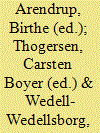

|
|
|
|
|
| Publication |
London, Curzon Press Ltd., 1986.
|
| Description |
vii, 175p.pbk
|
| Series |
Studies on Asian topics; no, 9
|
| Standard Number |
0700701745
|
|
|
|
|
|
|
|
|
|
|
|
Copies: C:1/I:0,R:0,Q:0
Circulation
| Accession# | Call# | Current Location | Status | Policy | Location |
| 027534 | 951.058/ARE 027534 | Main | On Shelf | General | |
|
|
|
|
| 5 |
ID:
178543
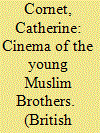

|
|
|
|
|
| Summary/Abstract |
This article examines Islamist engagement with popular culture in Egypt, focusing on Ikhwān Cinema a cultural intervention launched by a youth group affiliated with the Muslim Brotherhood, following the election of Mohamed Morsi as president in June 2012. Until now, scholars have tended to ignore Islamist-produced popular culture, reflecting assumptions that Islamists are opposed to popular culture, and even culture more broadly. Yet, as this article explores, the Muslim Brotherhood has historically viewed culture as an important vehicle through which to disseminate their ideas and to attract people to the organization. The first part of the article reviews the historical position of the Muslim Brotherhood towards the arts and cinema in order to put Ikhwān Cinema into context. The second part examines the aesthetic content of Ikhwān Cinema’s video productions, specifically created for social media consumption. The third part analyses how the group continued these aesthetics following the toppling of their political leader in July 2013. Overall, the article argues that we can understand Ikhwān Cinema both as a continuation of the Muslim Brotherhood’s historical engagement with culture as well as a case of a post-Islamist trend that seeks to blend Islam with elements of global youth culture.
|
|
|
|
|
|
|
|
|
|
|
|
|
|
|
|
| 6 |
ID:
142617
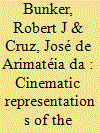

|
|
|
|
|
| Summary/Abstract |
This essay provides an overview of the eras of Mexican cinema followed by an analysis of 10 Spanish-language narco cinematic representations, an overview of the eras of American cinema followed by an analysis of 10 English language narco cinematic representations, and a conclusion that compares and contrasts the Mexican and US narco war cinematic experience. Due to divergent national trajectories – Mexico is engulfed in narco violence and corruption while the United States is not – more differences than similarities exist between these national cinematic genres. Dark spirituality themes are also increasingly evident in more recent narco war films.
|
|
|
|
|
|
|
|
|
|
|
|
|
|
|
|
| 7 |
ID:
098515
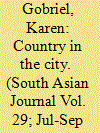

|
|
|
| 8 |
ID:
105836
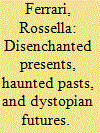

|
|
|
|
|
| Publication |
2011.
|
| Summary/Abstract |
Meng Jinghui's Chicken Poets (2002) presents a postmodern meditation on the state and fate of Chinese cultural production, intellectual discourse, and social relations at the turn of the century and the millennium. Albeit released two years after 2000, it retains symptomatic traits of the fin-de-siècle and millennial mentality and is therefore examined as an instance of 'deferred' or 'residual' millennialism. As typical of such narratives, it merges visions of hope and horror, dream and disaster. The film is founded on a dialogic intersection of multiple 'time-spaces' of signification, each providing a separate locus of reflection and critique. Besides disclosing distinct discursive targets, the structural interplay of these different chronotopes also establishes generic distinctions within the narrative. Chicken Poets relates to the present as a self-reflexive Künstlerfilm addressing the conflict of creation and commodity in times of mechanical reproduction and mediated stardom. Its enquiry into the past triggers ghostly resurrections and nostalgic visions of compensation and resistance. Its imagination of the future generates apocalyptic fantasies of disaster while disclosing prospects of redemption.
|
|
|
|
|
|
|
|
|
|
|
|
|
|
|
|
| 9 |
ID:
098514


|
|
|
| 10 |
ID:
126933
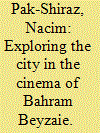

|
|
|
|
|
| Publication |
2013.
|
| Summary/Abstract |
This article explores five of Bahram Beyzaie's urban films over the last four decades to study their critique of the process of modernization and social changes that have taken place in Iran. These include The Journey (Safar, 1972), The Crow (Kalagh, 1977), Maybe Some Other Time (Shayad Vaqti Digar, 1987), Killing Mad Dogs (Sag Koshi, 2001) and When We Are All Asleep (Vaqti Hame Khabim, 2009). It examines the impact of modernization on the architecture and landscape of the city and consequently on the local community. It then studies the increasing complexity of ascertaining the real and unreal within the city. Finally, it looks at the changing values, the fears and threats within the city and the impact these have on its inhabitants, particularly women and their movement within the city.
|
|
|
|
|
|
|
|
|
|
|
|
|
|
|
|
| 11 |
ID:
098520
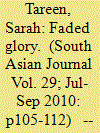

|
|
|
| 12 |
ID:
161646
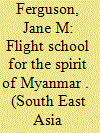

|
|
|
|
|
| Summary/Abstract |
In 1935, two Burmese filmmakers traveled to Tokyo with the intention of acquiring the latest sound recording equipment and training in sound-on-film production. In addition to these stated goals, in Japan they co-produced the feature film Japan Yin Thwe/Nippon Musume, ‘Japanese Darling.’ The film depicts daring young Burmese aviators and a budding romance with a Japanese woman. The active harnessing of the symbolic capital of aviation – the ideological notion of airmindedness – through the mimetic capacities of cinema, could be seen as a prescient example of Pan-Asianism, predating Daitoa Kyoeiken ‘Greater East-Asia Co-Prosperity Sphere’ propaganda. The film’s explicit encouragement of Burmese techno-nationalism offers a compelling contrast to other examples of anti-colonial nationalism, which emphasize notions of ethnic history and Buddhist morality and concerns of religious decline in the face of foreign imperialism. However, a comprehensive analysis of the film industry and commercial aviation in Japan in the 1930s reveals a structural impetus for this collaboration, arguably overshadowing ideological motivations and results.
|
|
|
|
|
|
|
|
|
|
|
|
|
|
|
|
| 13 |
ID:
082797
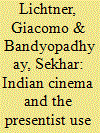

|
|
|
|
|
| Publication |
2008.
|
| Summary/Abstract |
This article critically assesses Deepa Mehta's Earth (1998) and Ashutosh Gowariker's Lagaan (2001) as cultural outputs of recent political and historical debates over the nature of India's nationhood. The article argues that the films politicize history, constructing an innocent past with the aim of advocating a more inclusive Indian society.
|
|
|
|
|
|
|
|
|
|
|
|
|
|
|
|
| 14 |
ID:
190717
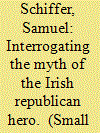

|
|
|
|
|
| Summary/Abstract |
This essay seeks to understand how since the signing of the Good Friday Agreement in 1998, marking the end of The Troubles in Northern Ireland, filmic depictions of the conflict reinterpret and interrogate the traditional role of the ‘hero’ in the Irish republican cause. In an analysis of two films released after the Good Friday Agreement, Hunger (2008) and The Wind that Shakes the Barley (2006), this essay argues that both films feature a hero-type Irish republican waging a brave-but-futile campaign against British oppression, but critique the myth of the Irish republican hero by severing the cycle of mythical violence by sowing doubt in the hero myth that serves as its base. This essay suggests that film is a low-stakes arena for the interrogation of volatile narratives that plays an important role in the reconceptualization of a conflict and, maybe even, its resolution.
|
|
|
|
|
|
|
|
|
|
|
|
|
|
|
|
| 15 |
ID:
091283


|
|
|
|
|
| Publication |
2009.
|
| Summary/Abstract |
This essay addresses itself to the century long history of cinema in Iran, focusing on the history of the senses as they combine with and are extended by film technologies. It argues that Khomeini's aim was to produce a transformed and Shiite Iran by purifying the sensorial national body by means of film technologies.
|
|
|
|
|
|
|
|
|
|
|
|
|
|
|
|
| 16 |
ID:
096967
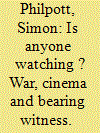

|
|
|
|
|
| Publication |
2010.
|
| Summary/Abstract |
War-on-terror-themed fictional films, particularly those focused on the war in Iraq, have largely failed at the box office and have been subjected to stinging criticism by right-wing political commentators and film reviewers. Critics on the political right have been upset by a perceived lack of patriotism in the films, often arguing that they are dangerous incitements to new acts of violence. However, unlike many earlier war films, including those made about the conflict in Vietnam, directors of films about the war on terror are quite self-consciously making political films that question United States (US) policy and practice, that focus on the effects of war on US service personnel and civilians in Iraq and Afghanistan and that, significantly, attempt to rehabilitate Arabs, Muslims and Islam from decades of Hollywood demonization. Moreover, the films are being made and released into a media environment in which quality news reporting has declined even as the intensity of feeling about 'otherness' has sharpened. This article argues that war on terror film directors are themselves bearing witness to the tragedy of war and thereby inviting film audiences to see the effects of war.
|
|
|
|
|
|
|
|
|
|
|
|
|
|
|
|
| 17 |
ID:
092060


|
|
|
|
|
| Publication |
2009.
|
| Summary/Abstract |
This article locates the contemporary security climate of the city of Los Angeles within a historical trajectory of modes of securitization. While some of the analysis treats the material and technological aspects of cities in general, and Los Angeles in particular, much of my emphasis, articulated in readings of both literary and film versions of police procedurals, is on discursive barriers. Ultimately, I suggest that, materially and discursively, urban America features class and ethnic fault lines that serve as the primary bases of security management.
|
|
|
|
|
|
|
|
|
|
|
|
|
|
|
|
| 18 |
ID:
098516
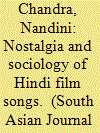

|
|
|
| 19 |
ID:
093726
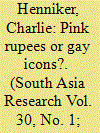

|
|
|
|
|
| Publication |
2010.
|
| Summary/Abstract |
Discussions of contemporary films and publications now illustrate the problematic terminology of terms like 'gay' or 'camp' in India, coupled with increasing speculation and reference to homosexuality. This article analyses media representations of Hindi cinema stars and highlights the emergence of some male stars as icons for gay communities within India and in the diaspora. Analysis of the way Bollywood celebrities are represented in India's press in-dicates that the media has been crucial for this emergence to occur. Focussing on Shah Rukh Khan, Bollywood's most recognisable and influential star today, the article argues that while a cult of interpretation surrounds Bollywood icons, there is a definite trend of stars confronting and negotiating sexually ambiguous spaces, both on screen and off. Media 'gossip' and specific public responses thus serve a variety of commercial as well as socio-cultural and wider political purposes.
|
|
|
|
|
|
|
|
|
|
|
|
|
|
|
|
| 20 |
ID:
097955
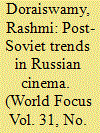

|
|
|
|
|
|
|
|